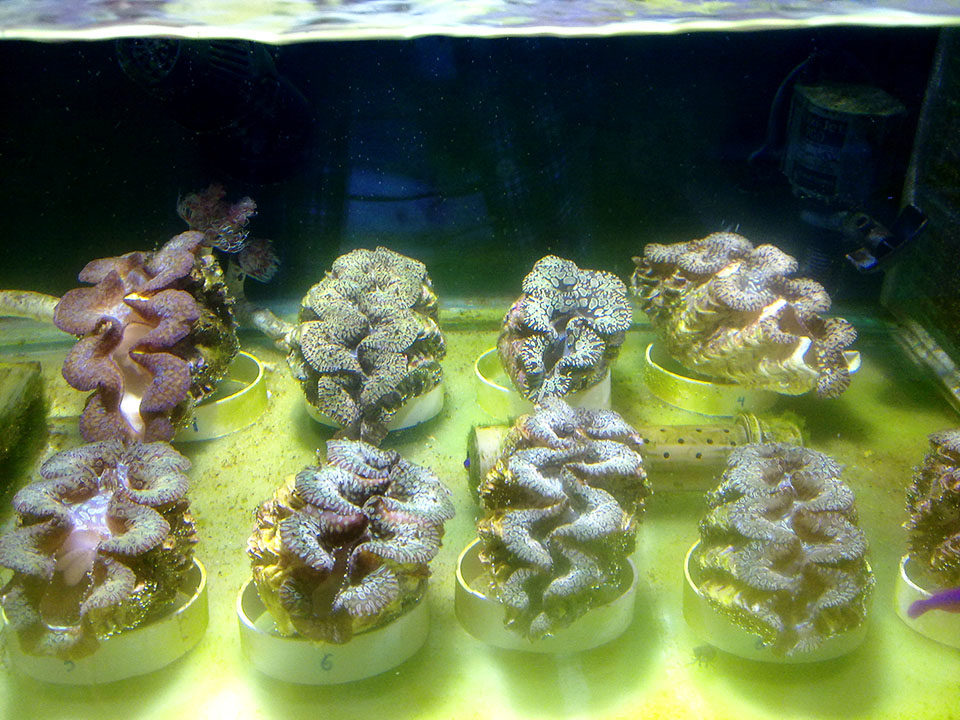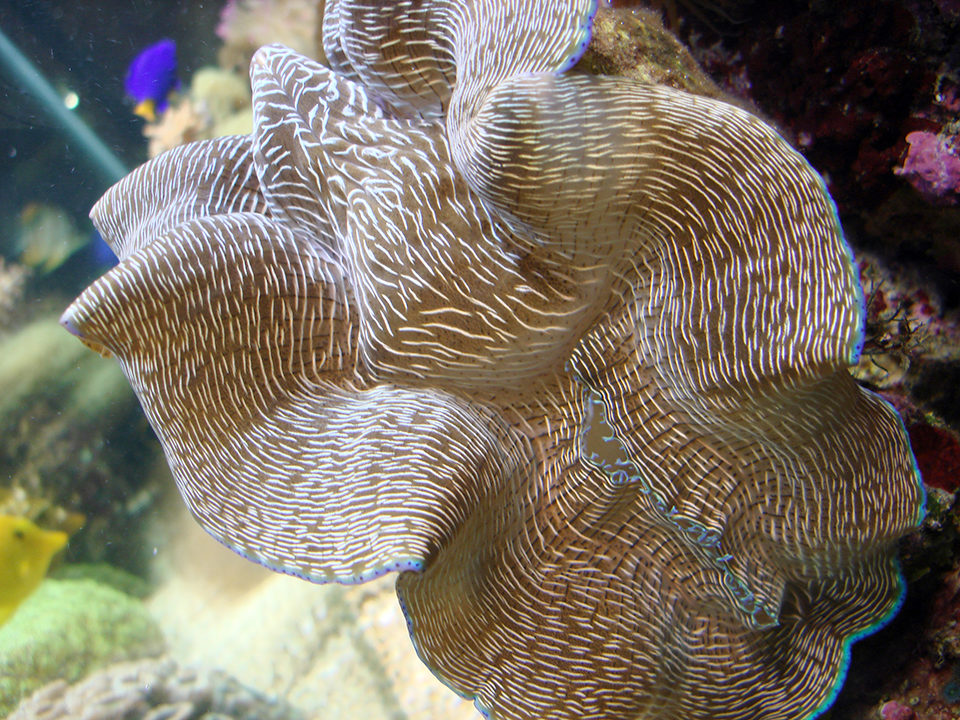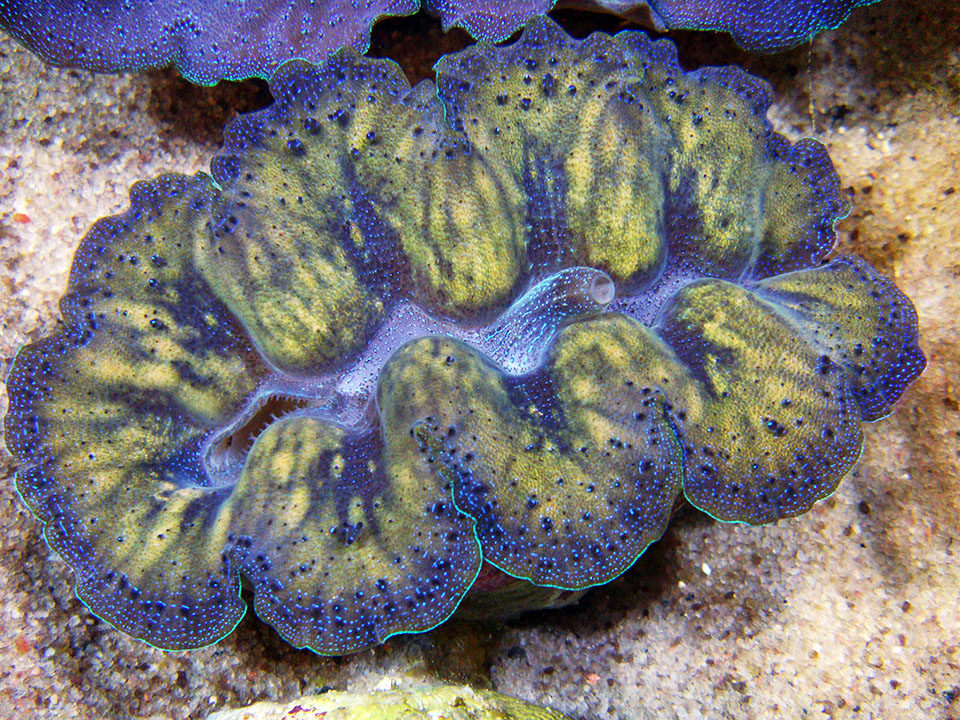Pacific Oceans species production has breeding, disease, restocking issues

Giant clams are today a heavily exploited resource and among the most coveted organisms found in coral reefs. Having colorful and hypertrophied mantles that harbors symbiotic dinoflagellates, giant clams are probably the most attractive invertebrates to the marine aquarium industry. The clams are also widely harvested as a food source in several countries in Asia and the Pacific Ocean. The mantle and adductor muscle are delicacies that are frequently exported to Japanese restaurants and used for sushi and soup flavoring.
The giant clam aquaculture industry is hardly catching up with the growing demand in both Western and Asian countries. Giant clam farming began mass production in the 1980s in Palau, but the production rates dropped in the following decades – so much that only a few dozen giant clam hatcheries are active in the world today. Most of the clam hatcheries are located in the Pacific Ocean and have relatively low production numbers, supplying only the local demand.
A variety of challenges combine to limit giant clam aquaculture production.
Broodstock availability
When running a giant clam hatchery, the amount and quality of broodstock are crucial factors for constant production. The ideal is having a minimum of 100 broodstock clams. A smaller broodstock base requires rotation, which can negatively affect gamete production. Giant clams have a gametogenic cycle of about six months, so it is not recommended to have broodstock clams spawn more than twice a year. Rotations frequently extenuate the adult clams.
Size is also significant, considering that giant clams are protandrous simultaneous hermaphrodites. They initially function as male only, but as size and gonads develop, the clams function simultaneously as male and female. Large individuals are necessary to have healthy, ripe and viable eggs. Broodstock must also be healthy, for primary energy must be allocated for gametogenesis, and not healing or fighting a parasite.
But large and healthy individuals are scarce in the market. Most of the operating hatcheries have few broodstock clams and seldom part ways with their adult individuals. Many countries that try to establish hatcheries rely on imported individuals, but have difficulty finding large clams. Disease outbreaks and deaths during transport are also common in imported clams, making it a challenge to acquire quality broodstock.
Considering that most of the current hatcheries have a limited amount of broodstock, rotations are employed, and as a consequence, the seed production is significantly low.
Induced spawning
Three main techniques are employed in induced spawning of giant clams. The first method is based on an intragonadal injection of serotonin, a natural neuro-transmitter in giant clams. In a second method, the gonads from a ripe individual are excised, blended and added to the tank in which the broodstock are held. The last method, heat shock, is performed by removing the broodstock from the water and laying the clams on their sides in the sun for a few hours.
Each of the methods has a particular problem. The serotonin method has by far the quickest response rate, but broodstock mortality is commonly reported. Since the gonads are relatively close to vital organs, it is common for the technician to perforate neighboring organs and consequently kill the clam. A potential solution that has been successful in trials is reaching the gonads through the byssal orifice instead of the mantle.
The macerated gonads method is quite effective, but requires the sacrifice of an adult clam. If broodstock availability is already a problem, this method should be avoided. Lastly, the heat shock method has an effectiveness problem. The induced broodstock often do not respond, and when they do, it is hours after the stimulus.

Diseases
The causes for giant clam diseases can be of parasitic, bacterial, protozoan or environmental character. The most common disease, the bleaching phenomenon, is generally of environmental nature. Very similar to what occurs in corals, adverse conditions such as high temperature and decreased pH cause the symbiotic dinoflagellates to be expelled, turning the clams’ mantles pale white.
However, the greatest cause for concern today is perkinsosis (also known as pinched mantle syndrome), a contagious disease caused by the apicomplexans Perkinsus species. This condition has become epidemic in some areas in Southeast Asia and is generally asymptomatic until the clams becomes ischemic. Its main symptoms include a retracted mantle, gaping and loss of byssal gland.
Unfortunately, little knowledge is available on the treatment of giant clam diseases. There are no treatment protocols, specific drugs or dosages for clam diseases, so panic often ensues when broodstock are infected.
Perkinsosis is the major cause for concern, with infected individuals internationally traded and now present in Asia, Europe and the Americas. There are no effective treatments reported for perkinsosis, and the extreme resistance of the trophozoite stage to salinity and temperature is a special aggravating factor. The use of antibiotics often backfires and kills the symbiotic dinoflagellates, which are close relatives of the Perkinsus species.
Restocking constraints
There has been significant fishing pressure on the natural stocks of giant clams. The larger species, Tridacna gigas and T. derasa, have been heavily exploited for their high meat content. Local extinctions have been reported in Fiji, the Philippines and several Micronesian Islands. Most species of giant clams are included on the International Union for Conservation of Nature Red List of threatened species.
Apart from the intense poaching and harvesting, natural recruitment in giant clams is significantly slow. Several restocking programs have been established, but the only one truly successful was implemented by Palau in the 1980s.
The main problem is the fact that aquaculture conditions in a laboratory are very different from those in the wild. Clams bred in indoor facilities and transplanted to coral reefs have suffered from the disparity in physical-chemical parameters as well as climatic events. Predation and poaching are also not present in laboratory conditions.
Further restocking problems are a consequence of broodstock issues. The limited number of broodstock leads to limited production of seed, which leads to a low number of successfully restocked clams. Moreover, the constant use of the same broodstock leads to inbreeding issues and little variability in the genetic pool.

Limited data
Statistics on worldwide giant clam aquaculture are limited. The United Nations Food and Agriculture Organization and the Secretariat of the Pacific Community have published some data, and some countries have annual reports of production. It is known that in the 2000s, about 200,000 live giant clams were internationally traded annually – exclusively for the aquarium trade.
Available data are often confusing, as the exact number of imported individuals may not exactly match the numbers of exported individuals. This further evidences the bureaucracy and traceability issues, especially in the ornamental industry, where retailers frequently do not know the exact sources of their clams. Moreover, there is no central source where one could find production information on any given giant clam producer.
Perspectives
To address industry challenges, clam hatcheries around the globe need to communicate with each other as well as universities and international aquaculture agencies. It is also important that such entities share information and resources.
Some of the issues can only be solved with extensive scientific research, so universities have a pivotal role to play in the sustainable production of giant clam seed. However, universities seldom have the infrastructure and devoted manpower that commercial hatcheries do. Therefore, breeders, scientists, researchers and governments should unite in enhancing worldwide giant clam aquaculture production.
(Editor’s Note: This article was originally published in the September/October 2013 print edition of the Global Aquaculture Advocate.)
Author
-
Miguel Mies
Oceanographic Institute
University of São Paulo, Brazil
Praça do Oceanográico
191, São Paulo - SP, 05508-120, Brazil
Tagged With
Related Posts

Innovation & Investment
Aquaculture in Canada: status, perspectives
Canada exports farmed seafood products to more than 22 countries and is the main seafood supplier to the U.S. market. Finfish, primarily salmon, production is strong and shellfish production is growing, but diversification will be imperative to maintain competitiveness.

Aquafeeds
Analyzing the hydrostability of shrimp feeds
The physical integrity and nutrient leaching of shrimp aquafeeds are important aspects in their quality control. The water stability of shrimp aquafeeds is often evaluated in various subjective manners. This analytical procedure provides a baseline for the aquafeed manufacturer to assess product quality.

Intelligence
Behold the nutritious oyster
Oysters provide important, natural filtration of water and are an important component of many healthy coastal ecosystems because their active filtering can help improve and maintain water quality. For many coastal communities, oysters are an important food resource and excellent sources of protein and amino acids, zinc, selenium, iron and B-vitamins.

Intelligence
Bahamas venture focuses on grouper, other high-value marine fish
A new venture under development in the Bahamas will capitalize on Tropic Seafood’s established logistics and infrastructure to diversify its operations from processing and selling wild fisheries products to include the culture of grouper and other marine fish.


